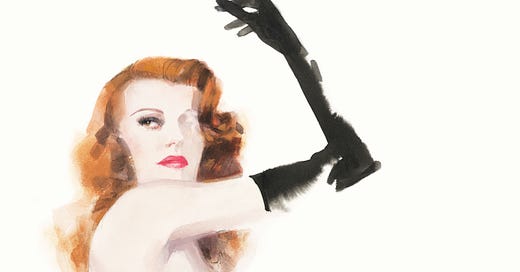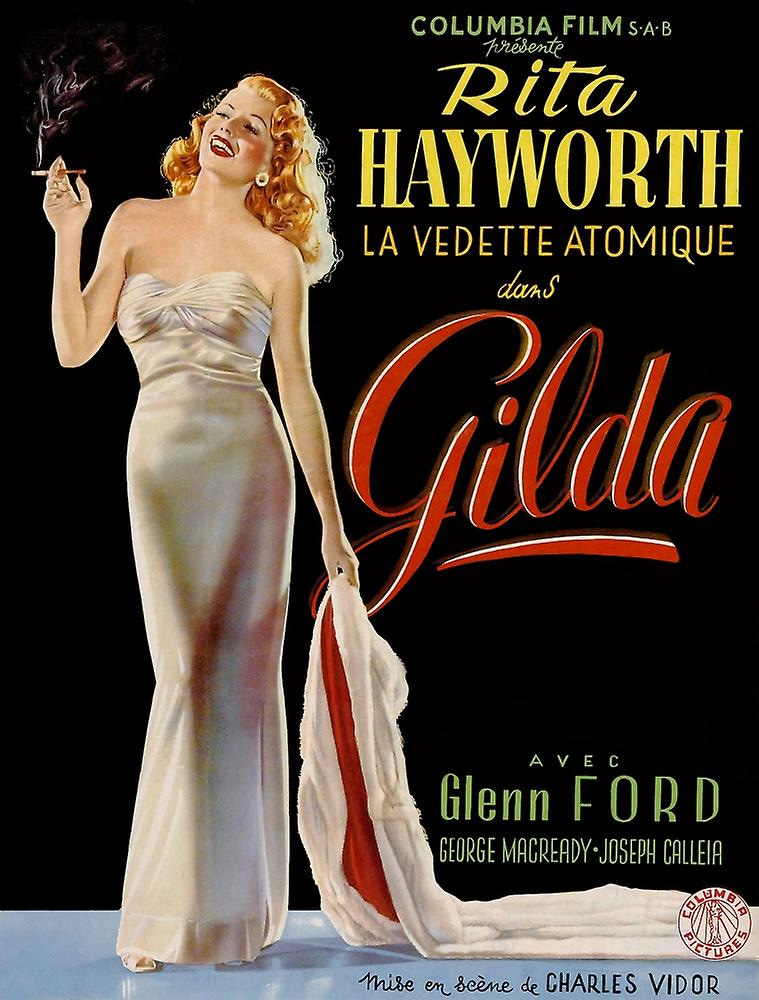There NEVER Was A Woman Like Gilda! declared the ads. And there never would be. Charles Vidor’s 1946 movie was Rita Hayworth’s apotheosis; The Love Goddess seen through through the distorting prism of film noir
Hayworth was born Margarita Carmen Cansino, in Brooklyn, in 1918. The family moved west and as a teenager she partnered her father, a professional Latin dancer, in a nightclub act and played bit parts in movies, invariably cast as an ‘exotic’. Seeking to Americanise her, Columbia Pictures changed her name and had her dye her hair red in anticipation of Technicolor. The parts got better.
As the predatory Dõna Sol in Blood And Sand (1941), she ran scarlet nails through Tyrone Power’s blue-black hair and the audience, like Power, shuddered with delight. But it was musicals that made her a star; No one danced like Rita Hayworth. Watch the hypnotic arabesques of her shoulders, arms and hands – the most beautiful in Hollywood. Even her hair was syncopated.
She became a favourite World War Two pin-up and as Gilda she was every returning GI’s wet dream and nightmare; A woman who couldn’t be tamed and shouldn’t be left alone. A guy might trust Betty Grable; But not Gilda.
Gilda’s plot, involving a perverse love triangle and some German agents in Argentina after the war echoed Hitchcock’s Notorious, released the same year. A down on his luck gambler, Johnny Farrell (Glenn Ford) is given a second chance by suave club owner Ballin Mundson (George Macready). Pretty soon Johnny is wearing tuxedos and is devoted to his boss’s every whim. Few missed the gay subtext. Things run smoothly until Mundson comes home from a trip married to Gilda. “Are you decent?” he says, pausing at her bedroom door. Gilda rises into the frame, tossing her hair. She spots Johnny, an old flame, and her eyes fill with what; contempt? longing? “Sure I’m decent,” she replies. It’s one of the great entrances in cinema.
The rest of the movie hinges on who will survive the shark pool of desire. “I hate you so much I think I’m going to die from it,” Gilda whispers rapturously into Johnny’s ear. The set piece in which she humiliates him by performing a striptease (she only removes a glove) and sings Put the Blame on Mame is justly famous. Jack Cole did the choreography, Anita Ellis provided the vocal, Jean Louis the dress and Rudolph Maté the photography. But it is Hayworth’s moment. A distillation of what it meant to be a star. And what it still means. The film contorted its self into a happy ending. Hayworth was not so lucky, “Every man I knew went to bed with Gilda … and woke with me,” she observed. Lets watch it – again – tonight.








Who knew David Downton would turn out to be as great a writer as he is an artist! He seems to find the most amazing tidbits in the world of glamour.
What’s amazing is that in the movie of “Pal Joey” Rita Hayworth, again dressed by Jean Louis did the number Zip, where again gloves were the extent of the strip!